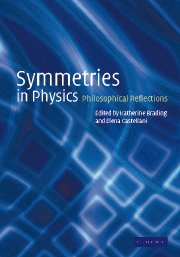1 - Introduction
Published online by Cambridge University Press: 08 October 2009
Summary
This book is about the various symmetries at the heart of modern physics. How should we understand them and the different roles that they play? Before embarking on this investigation, a few words of introduction may be helpful. We begin with a brief description of the historical roots and emergence of the concept of symmetry that is at work in modern physics (section 1). Then, in section 2, we mention the different varieties of symmetry that fall under this general umbrella, outlining the ways in which they were introduced into physics. We also distinguish between two different uses of symmetry: symmetry principles versus symmetry arguments. In section 3 we change tack, stepping back from the details of the various symmetries to make some remarks of a general nature concerning the status and significance of symmetries in physics. Finally, in section 4, we outline the structure of the book and the contents of each part.
The meanings of symmetry
Symmetry is an ancient concept. Its history starts with the Greeks, the term συμμετρíα deriving from σύν (with, together) and μέτρоν (measure) and originally indicating a relation of commensurability (such is the meaning codified in Euclid's Elements, for example). But symmetry immediately acquired a further, more general meaning, with commensurability representing a particular case: that of a proportion relation, grounded on (integer) numbers, and with the function of harmonizing the different elements into a unitary whole (Plato, Timaeus, 31c):
- Type
- Chapter
- Information
- Symmetries in PhysicsPhilosophical Reflections, pp. 1 - 18Publisher: Cambridge University PressPrint publication year: 2003
- 2
- Cited by

